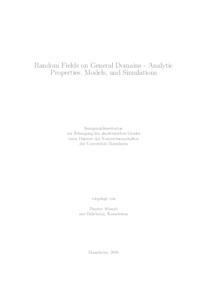|
Random fields on general domains - analytic properties, models, and simulations
Schwab, Dimitri
![[img]](https://madoc.bib.uni-mannheim.de/45548/1.hassmallThumbnailVersion/DimitriSchwab_final.pdf)  Vorschau |
|
PDF
DimitriSchwab_final.pdf
- Veröffentlichte Version
Download (16MB)
|
|
URL:
|
https://madoc.bib.uni-mannheim.de/45548
|
|
URN:
|
urn:nbn:de:bsz:180-madoc-455481
|
|
Dokumenttyp:
|
Dissertation
|
|
Erscheinungsjahr:
|
2018
|
|
Ort der Veröffentlichung:
|
Mannheim
|
|
Hochschule:
|
Universität Mannheim
|
|
Gutachter:
|
Schlather, Martin
|
|
Datum der mündl. Prüfung:
|
22 Juni 2018
|
|
Sprache der Veröffentlichung:
|
Englisch
|
|
Einrichtung:
|
Fakultät für Wirtschaftsinformatik und Wirtschaftsmathematik > Applied Stochastics (Schlather 2012-)
|
|
Fachgebiet:
|
510 Mathematik
|
|
Normierte Schlagwörter (SWD):
|
Zufälliges Feld , Zufälliges Mosaik , Sphäre , Stetigkeit , Simulation
|
|
Freie Schlagwörter (Englisch):
|
Random Fields , Continuity , Covariance Function , Sphere , Simulation , Random Mosaic , Turning Bands
|
|
Abstract:
|
The present thesis addresses two aspects of random fields: sample continuity and the simulation of random fields.
In the first part of the thesis we formulate and prove a local and a global variant of the Kolmogorov-Chentsov theorem for random fields on metric spaces. From this we obtain a theorem for random fields on Riemannian manifolds that is easy to apply and yields the existence of a modification which is locally uniformly sample continuous or locally Hölder sample continuous.
In the second part we present a model of a random field on a topological space that unifies well-known models such as the Poisson hyperplane tessellation model, the random token model, and the dead leaves model. In addition to generalizing these submodels from R^d to other spaces such as the d-dimensional unit sphere S^d, our construction also extends the classical models themselves, e.g. by replacing the Poisson distribution by an arbitrary discrete distribution. Moreover, the method of construction directly produces an exact and fast simulation procedure. By investigating the covariance structure of the general model we recover various explicit correlation functions on R^d and S^d and obtain several new ones.
This second part also contains a proof of the spectral turning bands method on S^d, which has the same properties as its analogue in R^d.
|
 | Dieser Eintrag ist Teil der Universitätsbibliographie. |
 | Das Dokument wird vom Publikationsserver der Universitätsbibliothek Mannheim bereitgestellt. |
 Suche Autoren in Suche Autoren in
Sie haben einen Fehler gefunden? Teilen Sie uns Ihren Korrekturwunsch bitte hier mit: E-Mail
Actions (login required)
 |
Eintrag anzeigen |
|
|
